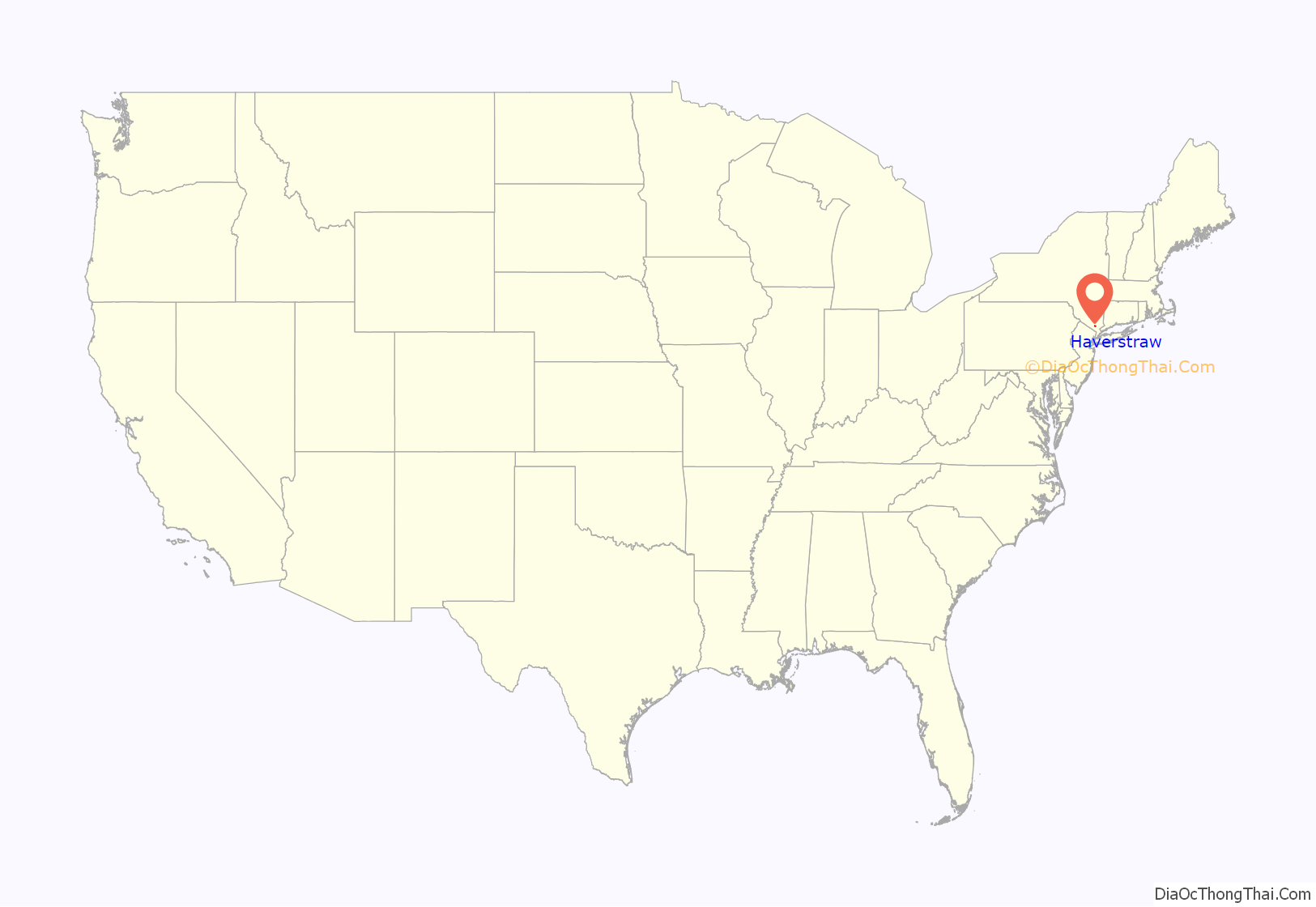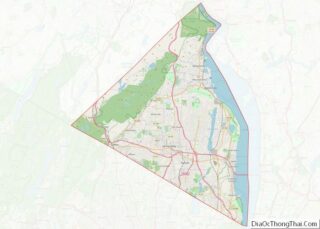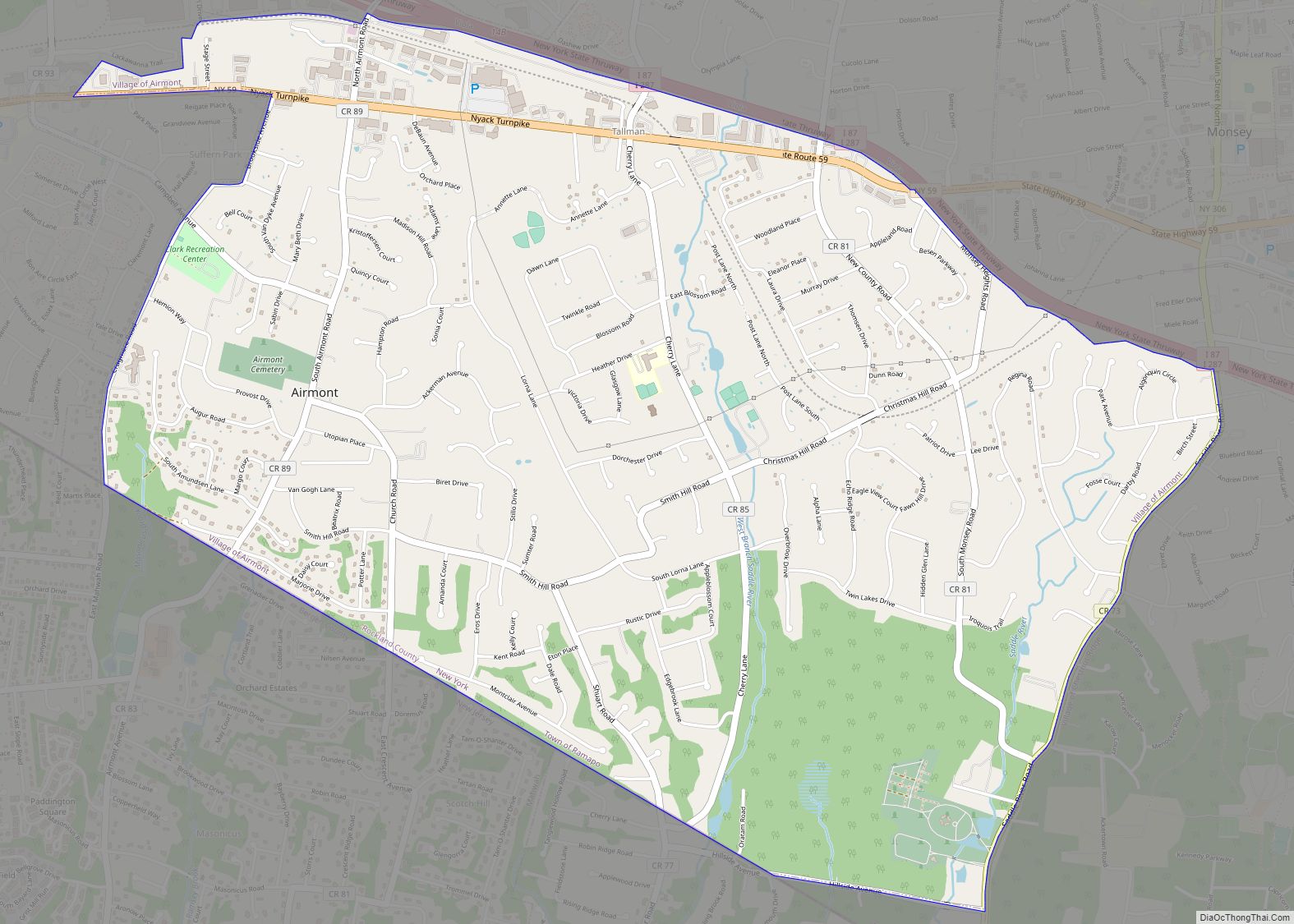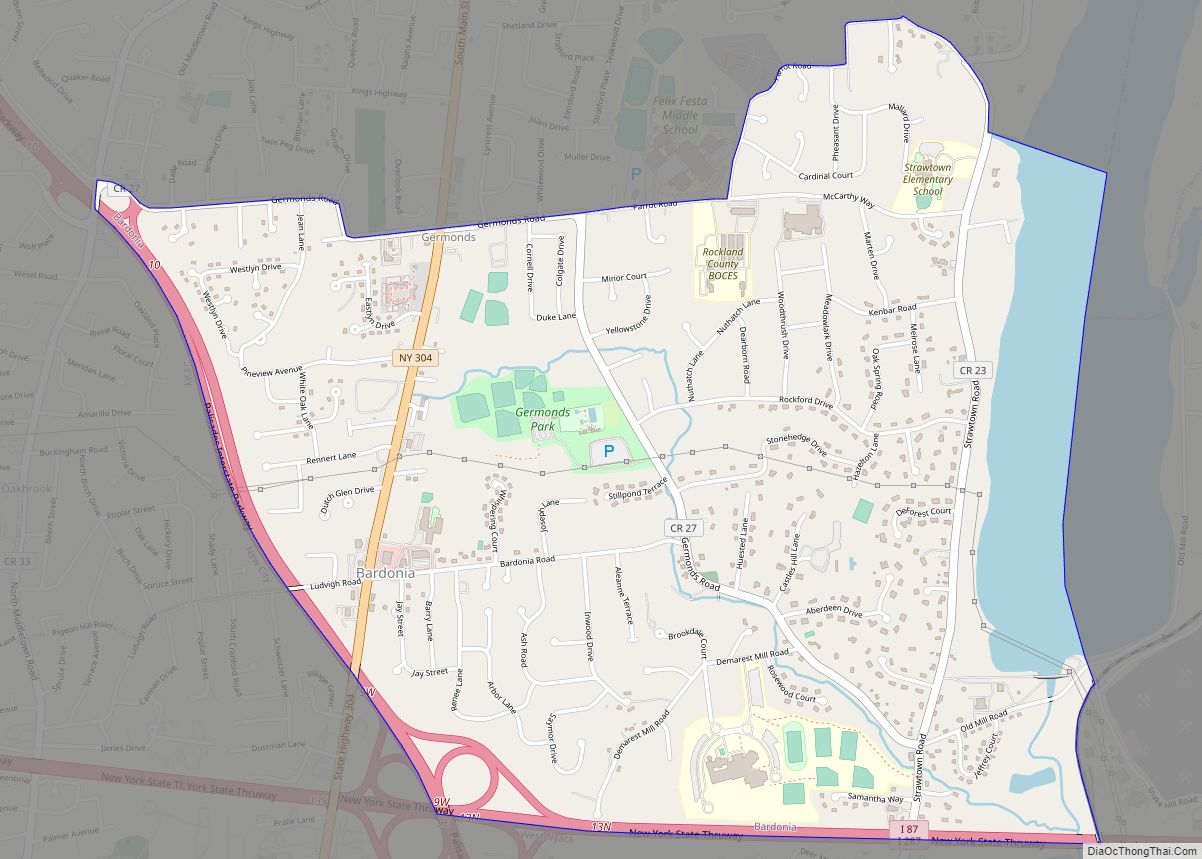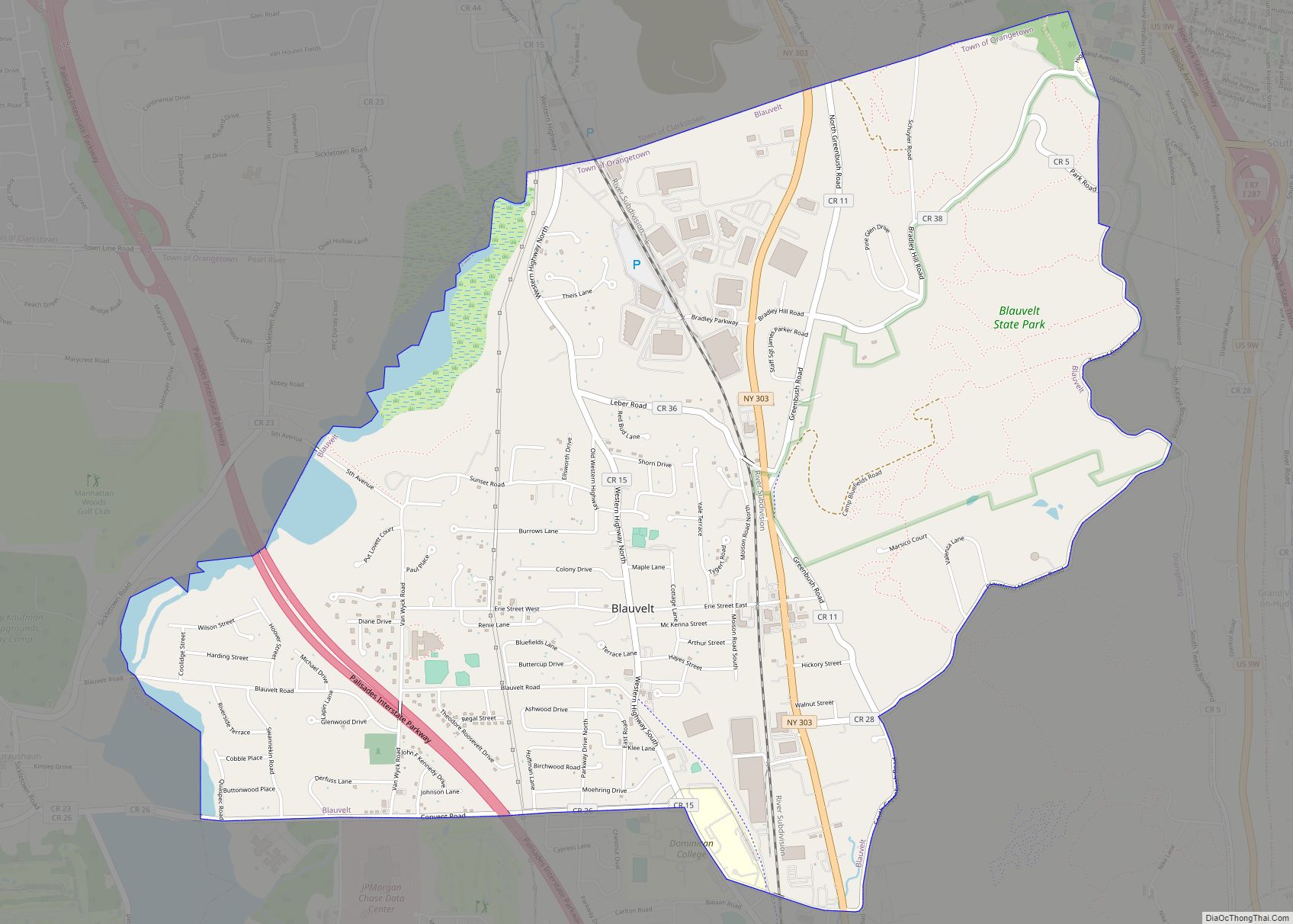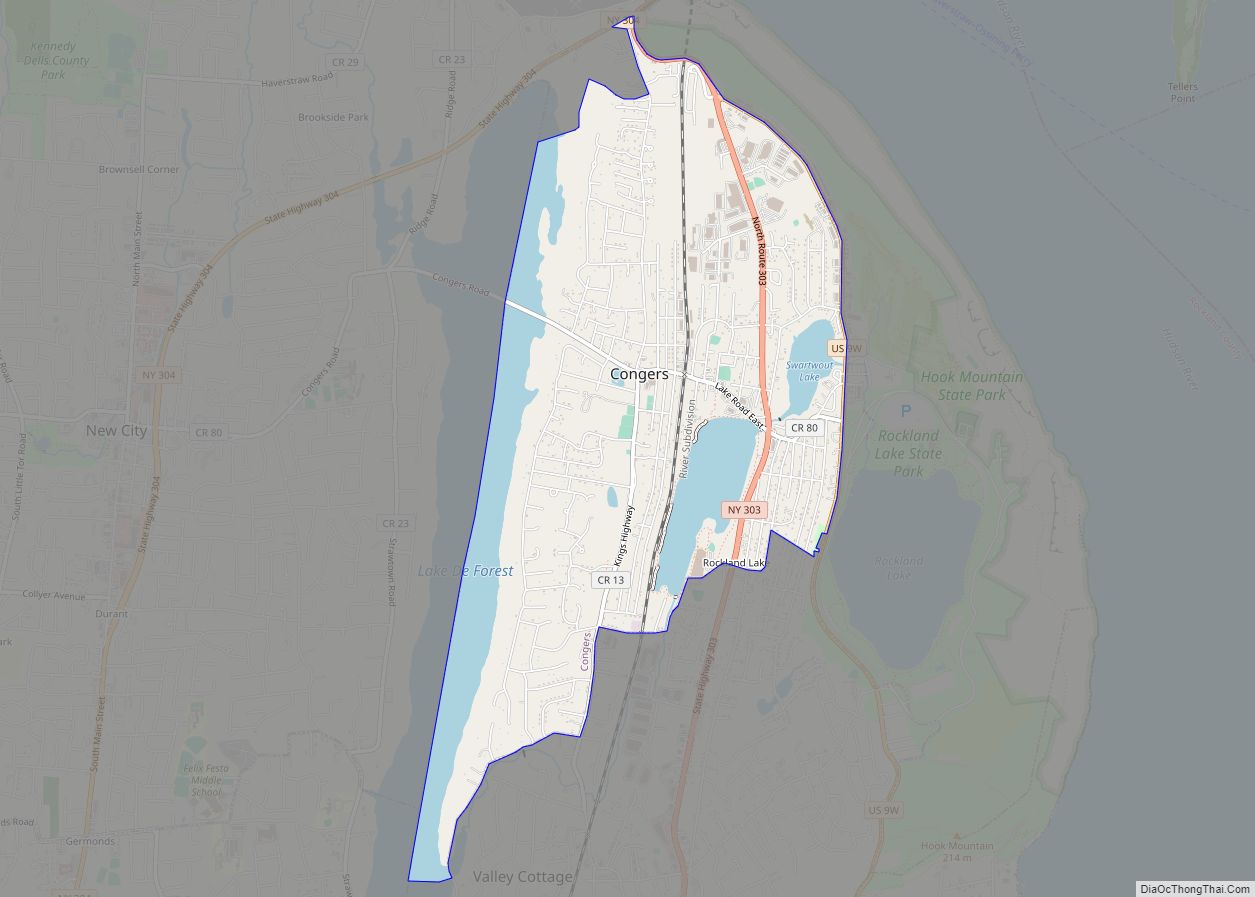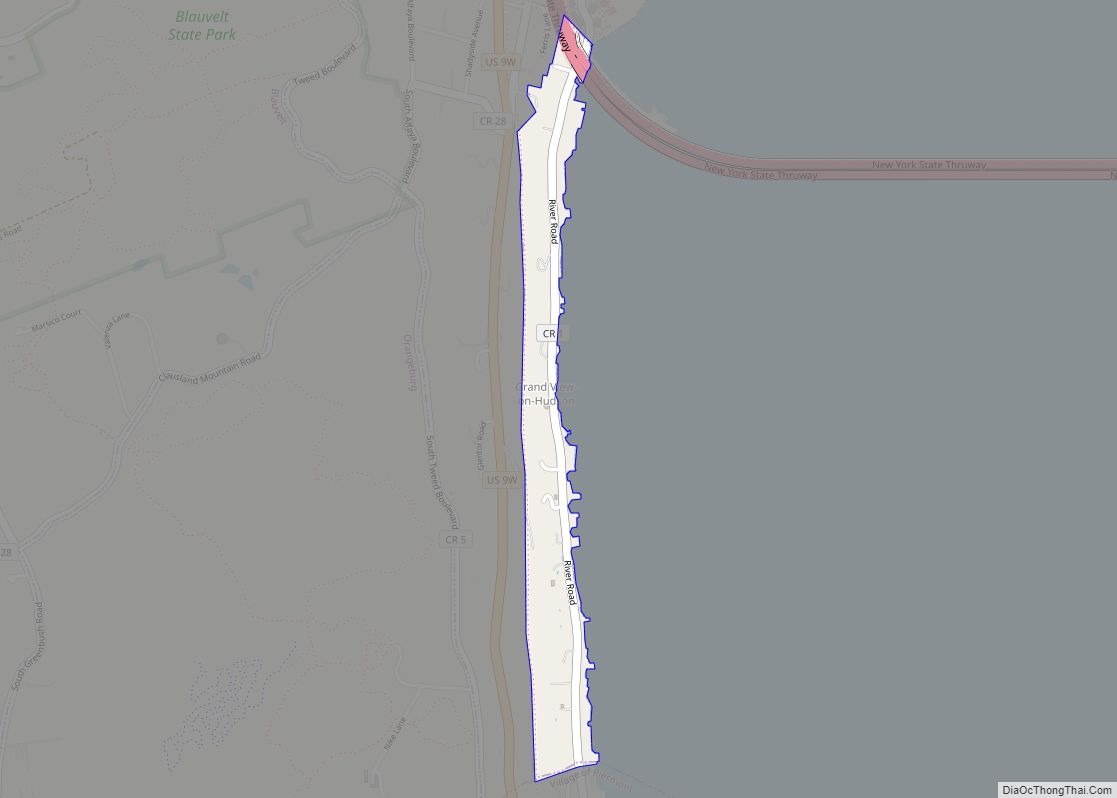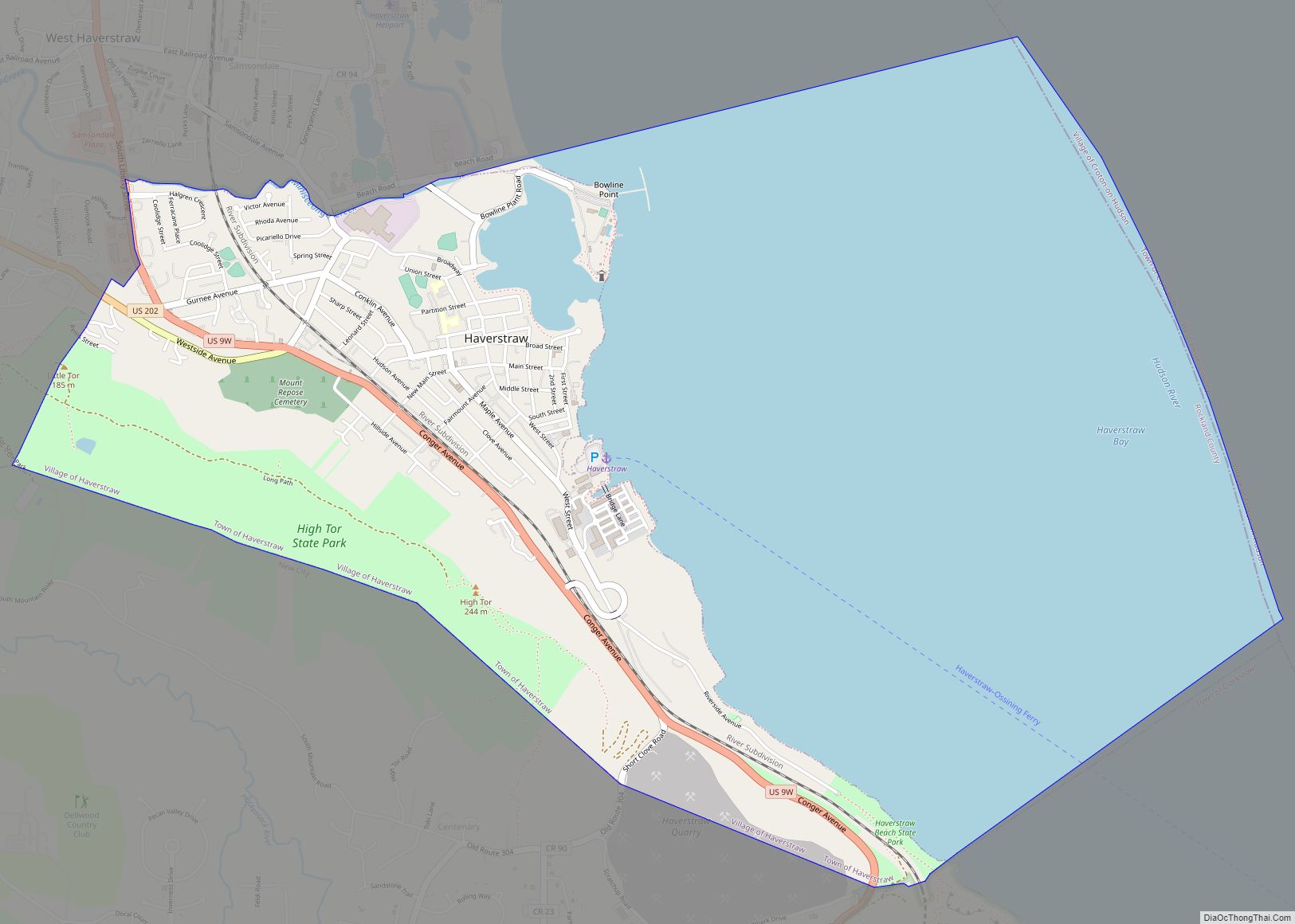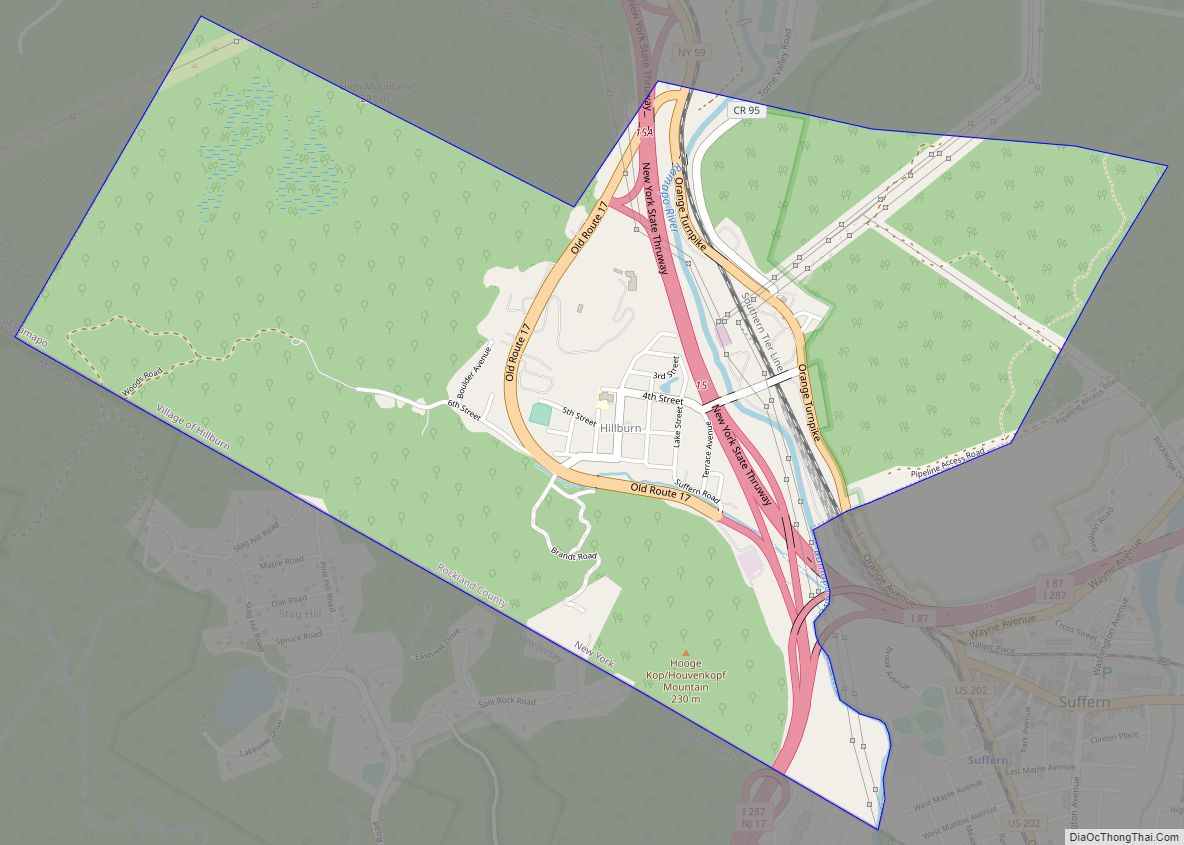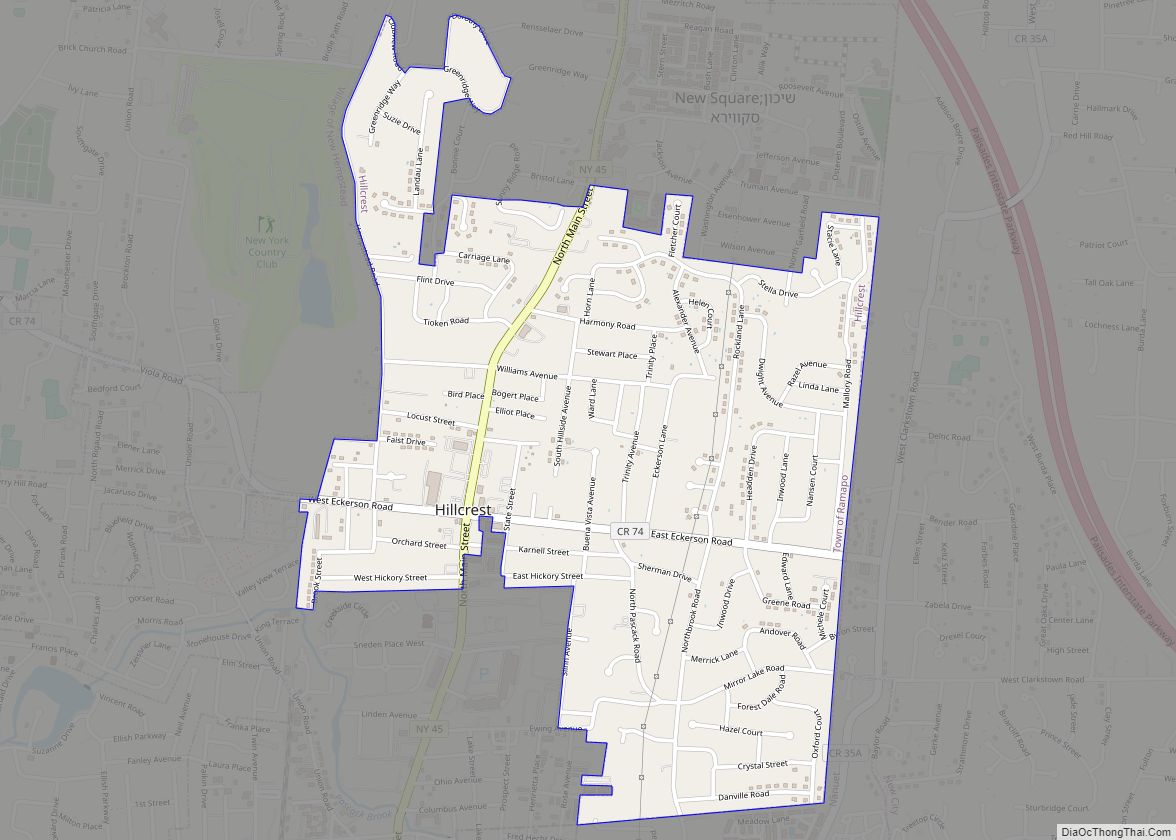Haverstraw is a village incorporated in 1854 in the town of Haverstraw in Rockland County, New York, United States. It is located north of Congers, southeast of West Haverstraw, east of Garnerville, northeast of New City, and west of the Hudson River at its widest point. According to the 2019 U.S. Census estimate, the population was 12,045, an increase from the 2010 Census population of 11,910.
The village of Haverstraw is within the North Rockland Central School District public primary and secondary school system of New York State, and the downtown hosts the Rockland Community College – Haverstraw Extension Center. As of 2009, the mayor is Michael Kohut.
| Name: | Haverstraw village |
|---|---|
| LSAD Code: | 47 |
| LSAD Description: | village (suffix) |
| State: | New York |
| County: | Rockland County |
| Incorporated: | 1854 |
| Elevation: | 30 ft (9 m) |
| Total Area: | 5.04 sq mi (13.06 km²) |
| Land Area: | 1.98 sq mi (5.14 km²) |
| Water Area: | 3.06 sq mi (7.92 km²) |
| Total Population: | 12,323 |
| Population Density: | 6,211.19/sq mi (2,398.04/km²) |
| ZIP code: | 10927 |
| Area code: | 845 |
| FIPS code: | 3632754 |
| GNISfeature ID: | 0952388 |
| Website: | www.voh-ny.com |
Online Interactive Map
Click on ![]() to view map in "full screen" mode.
to view map in "full screen" mode.
Haverstraw location map. Where is Haverstraw village?
History
Settlement (1609–1750)
Before Dutch settlers traveled to the Hudson River Valley in the early part of the seventeenth century, the Rumachenanck people, a subset of the Lenape tribe, called the area home. In 1609, during one of the many voyages the Dutch financed in search of the Northwest Passage, Henry Hudson sailed the Hudson River.
The village is one of the first to appear on maps of North America, listed as Haverstroo, which means “oat straw” as an anglicized version of a Dutch word. The area was first referred to as Haverstroo in 1616. From 1686 till 1719, the present town of Haverstraw was included in the laws, taxes and militia duties of Orangetown. But that valley was increasing so rapidly in population, the distance was so great and the trail so poor between it and Tappan, that the inhabitants petitioned for separate existence and on June 24, 1719, the following act was passed: “An Act to enable the Precincts of Haverstraw in the County of Orange, to chuse a Supervisor, a Collector, two Assessors, one Constable, and two Overseers of Highways.”
The village was not incorporated as a municipality until March 11, 1854, as the Village of Warren, after Joseph Warren, a major general who died at the Battle of Breed’s Hill (a.k.a. Bunker Hill) in 1775 during the Revolutionary War. Haverstraw has a complicated record of names. One Act refers to the Village of Waynesburgh, and will take an extract from this Act, passed April 1, 1814, again: “from thence, in a direct course as nearly as may be, to such a point in the village of Waynesburgh, late Warren, as the Commissioners, etc.” For what reason the name Waynesburgh was given to the hamlet, and the length of time it remained 1883–84, have escaped search, but it is likely that the interim name was in honor of revolutionary General Anthony Wayne. Warren, the hamlet had already been called, and to Warren it was changed again. But this name was never a popular one. People had long been accustomed to blend the name of the township and village in one, and call the latter, Haverstraw. At the establishment of the present Stony Point post office in 1847, it was named North Haverstraw. Commerce was carried on, not with Warren, but Haverstraw, and the name of the village post office was Haverstraw from its organization. Influenced by these and other less important reasons, the residents of the village appealed to the Legislature for relief, and, on April 14, 1874, that body passed the following act:
“SECTION I. The name of the Village of Warren in the County of Rockland, incorporated under the provisions of the Statute of the State of New York, authorizing the incorporation of villages, is hereby changed to ‘Haverstraw.’ All proceedings now pending by or against the said Village of Warren shall be continued in the name of Haverstraw.”
This village did not begin its growth as early as either Ramapo or Nyack, but for many years, until the discovery of James Wood revolutionized brick making, remained a country hamlet. In 1855, Jacob Wan-dell wrote in a letter to his sister Catherine Van Houten, the following description of the present village, at the close of the last century: “My father removed from Tappan Sloat to Haverstraw in the year 1794. There was no village there then, only one house. Captain Shepherd bought the field where the village is built, of Joseph Allison, for £10 ($25), an acre. When he moved there, it was sown with rye. The river bank was the handsomest I ever saw. From Grassy Point down to where James Wood first set a brick- yard, (this was on the river bank directly opposite the burying ground of the De Noyelles family), was a beautiful row of large chestnuts and oak trees, growing all along the banks. It was a beautiful walk.”
American Revolution (1775–1783)
Strategically located on the Hudson River, the village was home to a number of skirmishes between the British Army and the Continental Army during the American Revolutionary War.
The peak of High Tor Mountain on the Long Path hosted Continental Army watchfires to communicate between troops installments up and down the Hudson River. Today, watchfires are an annual Memorial Day tradition in Haverstraw. Watchfires are lit at midnight on May 30 and burn for 24 hours.
Haverstraw was the site of the most grievous treason of the early years of the United States. During the night of September 21–22, 1780, the English emissary, Major John André, was rowed from the sloop-of-war Vulture to a beach below the Long Cove on the southern boundary of Haverstraw. The negotiations to sell the plans to West Point were not completed by dawn, and Benedict Arnold and André traveled to the Belmont House, owned by Thomas Smith and occupied by his brother Joshua Hett Smith, on the grounds of what is now Helen Hayes Hospital in West Haverstraw. The house has since been known as the Treason House.
95th New York Volunteer Infantry
The 95th New York Volunteer Infantry fought in the American Civil War under the command of Ulysses S. Grant, Major General James Samuel Wadsworth and Brigadier General Edmund Rice. Company F was recruited primarily from Haverstraw. The infantry joined in the action of the Railroad Cut on the first day of the Battle of Gettysburg. They fought many battles, including the Battle of Mine Run, Grant’s Overland Campaign, the Battle of the Wilderness, Spotsylvania Court House, North Anna, Cold Harbor and the Siege of Petersburg. They saw the war to the end, including engagements in the Battle of the Weldon Railroad, the Battle of Hatcher’s Run, and the Appomattox Campaign.
Brick-making capital of the world
Commonly referred to as “Bricktown”, Haverstraw was famous for its brick-making, which was a major industry for the village. Brick-making was so popular due to the clay formed by the Hudson River’s water and the rich soil that lined Haverstraw’s waterfront, that it was nicknamed the “brickmaking capital of the world”. Many of the old brownstone and brick structures that were constructed in New York City in the late 1890s-early 1900s were composed of bricks manufactured by Haverstraw. In the early 20th century, there were more than 40 brick-making factories lining the Hudson River within the village. Although brick-making involved all ethnic groups, 60 percent of the brickyard workers were African-Americans.
Brick manufacturers circa 1910
This is a list of suppliers of bricks to New York City metropolitan areas in 1910 with the numbers of machines each manufacturer used, as listed in Within These Gates by Daniel deNoyelles:
Other history
The brick industry continued to thrive until World War II, when brick began to lose its value significantly. Shortly after, the village’s main industry of brickmaking declined and left the village. The economic vitality of the village greatly decreased. Because of the amount of vacancies and the relatively inexpensive housing available, the village opened up to Hispanic migration, and the village has become home to many Hispanic immigrant families since the 1950s. Many families of Hispanic descent take part in the village’s annual festivals. The Puerto Rican Day Parade and Festival take place in the village’s downtown in early June, and the Dominican Day Parade and Festival occur in late August and in September.
On the night of January 8, 1906, a landslide destroyed a large residential and commercial portion of the village. Firefighters responded immediately but faced enormous odds because of burst valves and water mains, natural gas explosions and hoses which periodically froze because of the extreme cold. The landslide, a pit about 150 feet (46 m) deep, claimed five Haverstraw blocks from Allison to Jefferson Street, 21 buildings, and the lives of 4 firefighters and 17 residents. Despite the events, the village rebounded. Eight years later, however, the Cleary-Newman murder took place, which cast a pall of corruption over the populace. In 2007, leaders of the village and town announced the 101st anniversary of the landslide and dedicated a memorial to the victims of the disaster. The memorial is located at Bowline Town Park on the shore of Bowline Pond and the Hudson River.
In July 1920, New York Yankees outfielder Babe Ruth spent time in Haverstraw to film a movie – Headin’ Home. A local baseball field bears the Hall of Famer’s name due to his visit.
George M. Cohan, the “Father of Modern Broadway”, had his debut playing the violin at the Waldron’s Opera House on Broadway in the village. The Cohan family stayed in Haverstraw during summer while making their rounds on the vaudeville circuit. The Cohans lived on Division Street, next to a major clay pit in the Village. Cohan was influenced early in his life by the songs of the southern black clay diggers that worked down below the Cohan house in the clay pit. It is often said that Cohan mainstreamed ragtime and jazz through his Broadway tunes.
September 2004 marked the village’s 150th anniversary, celebrated by a festival along the village’s waterfront. The village has entered a period of revitalization, which coincides with the creation of the Harbors at Haverstraw Community and a sculpture trail which will follow the Hudson River shoreline. The Harbors at Haverstraw is situated on the southern end of the Village and below the higher elevations of the charming riverside southernmost neighborhood known as Dutchtown. Some residents have taken to calling the Harbors area the “South End” instead of the previous name for the neighborhood the “mud hole” in honor of various clay pits once visible here. The State has funded $3 million to the revitalization project, which includes investments on the waterfront esplanade and a possible downtown streetscape project.
As a cost-saving measure, at midnight on January 1, 2006, the Village of Haverstraw Police Department was merged with the Town of Haverstraw Police Department. The town of Clarkstown Police opened a new shooting range that town of Haverstraw and other departments use at Tilcon Quarry area. Its noise issue were addressed and ongoing issues of Oldcastle, Tilcon and CRH blasting and pollution might soon be addressed in 2017 or 2018.
Camp Christmas Seals
Camp Christmas Seals – (interracial camp), where children were aided by the Methodist Camp Service. Mrs. Addie C. Cox, director, the “mother” of all the campers. Activities included boating, fishing and swimming at nearby Lake Tiorati, one of the seven main lakes in Harriman State Park, located in Orange County, New York.
Haverstraw Road Map
Haverstraw city Satellite Map
Geography
Haverstraw is on the west bank of the Hudson River. Haverstraw Bay is the widest portion of the Hudson River. The bay is bordered by the village of Haverstraw and the village of Croton-on-Hudson in Westchester County to the east.
Haverstraw is located at 41°11′47″N 73°58′0″W / 41.19639°N 73.96667°W / 41.19639; -73.96667 (41.196494, −73.96684).
According to the United States Census Bureau, the village has a total area of 5.1 square miles (13.1 km), of which 2.0 square miles (5.2 km) is land and 3.1 square miles (8.0 km), or 60.75%, is water.
See also
Map of New York State and its subdivision:- Albany
- Allegany
- Bronx
- Broome
- Cattaraugus
- Cayuga
- Chautauqua
- Chemung
- Chenango
- Clinton
- Columbia
- Cortland
- Delaware
- Dutchess
- Erie
- Essex
- Franklin
- Fulton
- Genesee
- Greene
- Hamilton
- Herkimer
- Jefferson
- Kings
- Lake Ontario
- Lewis
- Livingston
- Madison
- Monroe
- Montgomery
- Nassau
- New York
- Niagara
- Oneida
- Onondaga
- Ontario
- Orange
- Orleans
- Oswego
- Otsego
- Putnam
- Queens
- Rensselaer
- Richmond
- Rockland
- Saint Lawrence
- Saratoga
- Schenectady
- Schoharie
- Schuyler
- Seneca
- Steuben
- Suffolk
- Sullivan
- Tioga
- Tompkins
- Ulster
- Warren
- Washington
- Wayne
- Westchester
- Wyoming
- Yates
- Alabama
- Alaska
- Arizona
- Arkansas
- California
- Colorado
- Connecticut
- Delaware
- District of Columbia
- Florida
- Georgia
- Hawaii
- Idaho
- Illinois
- Indiana
- Iowa
- Kansas
- Kentucky
- Louisiana
- Maine
- Maryland
- Massachusetts
- Michigan
- Minnesota
- Mississippi
- Missouri
- Montana
- Nebraska
- Nevada
- New Hampshire
- New Jersey
- New Mexico
- New York
- North Carolina
- North Dakota
- Ohio
- Oklahoma
- Oregon
- Pennsylvania
- Rhode Island
- South Carolina
- South Dakota
- Tennessee
- Texas
- Utah
- Vermont
- Virginia
- Washington
- West Virginia
- Wisconsin
- Wyoming
